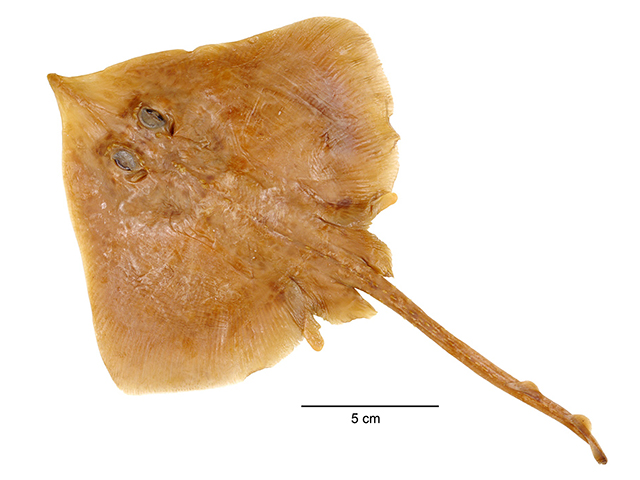|
This species is distinguished by the following characters: disc rhombic to evenly inverse heart-shaped (in adult male), with angled outer corners, its body length to mid-vent shorter than tail length from mid-vent; preorbital snout length 13-15% and distance between first gill slits 15-16% of TL; orbits are large, horizontal diameter 1.1-1.4 times interorbital width; young specimens with 1-3 rows of tail thorns, adults 3-5; more than two interdorsal and nuchal thorns; dorsally, it is largely smooth, but snout tip prickly; with growth, dermal denticles also on anterior margins of disc and inner posterior pectorals, as well as ventrally on snout and anterior margins of disc; ventral snout tip blackish, especially in young specimens; dorsal ground color ocher, anterior snout dusky; its dorsal pattern on disc and pelvic fins consisting of variable dark brown spots encircled with beige pigment and arranged into rosettes; ventral pores are few, tiny, and blackish; long interdorsal and postdorsal tail sections, with high posterior part of epichordal caudal lobe and light edged low ventral keel; 37-42 upper tooth, relatively few pectoral fin radials (71-75); clasper without external pseudosiphon and funnel; inner dorsal lobe with components slit, terminal bridge, and 2 clefts; inner ventral lobe with components shield, dike, rhipidion, sentinel, spike, and two sentinas; terminal clasper skeleton with 3 dorsal terminal, 1 ventral terminal, and 2 accessory terminal cartilages; unlike its congener, its ventral terminal is atypically broad distally, the accessory terminal 1 is only slightly Y-shaped, and the dorsal terminal 2 and the terminal bridge are fused; anterior cranial fontanel with clear-cut contour all around and extending about one fifth into rostral shaft length; subrectangular scapulocoracoid, with rear corner sharply marked; large oval anterior fenestra without anterior bridge, one large oval postdorsal and one lower, moderately large oval postventral fenestra; its pelvic girdle with massive ischiopubic bar with weakly convex anterior contour, posterior contour slightly concave in females and juvenile males but deeply concave in semi adult and adult males; prepelvic processes are moderately long, solid, conical, and straight, their length 2.4-2.9 times median thickness of ischiopubic bar (Ref. 101518). |

